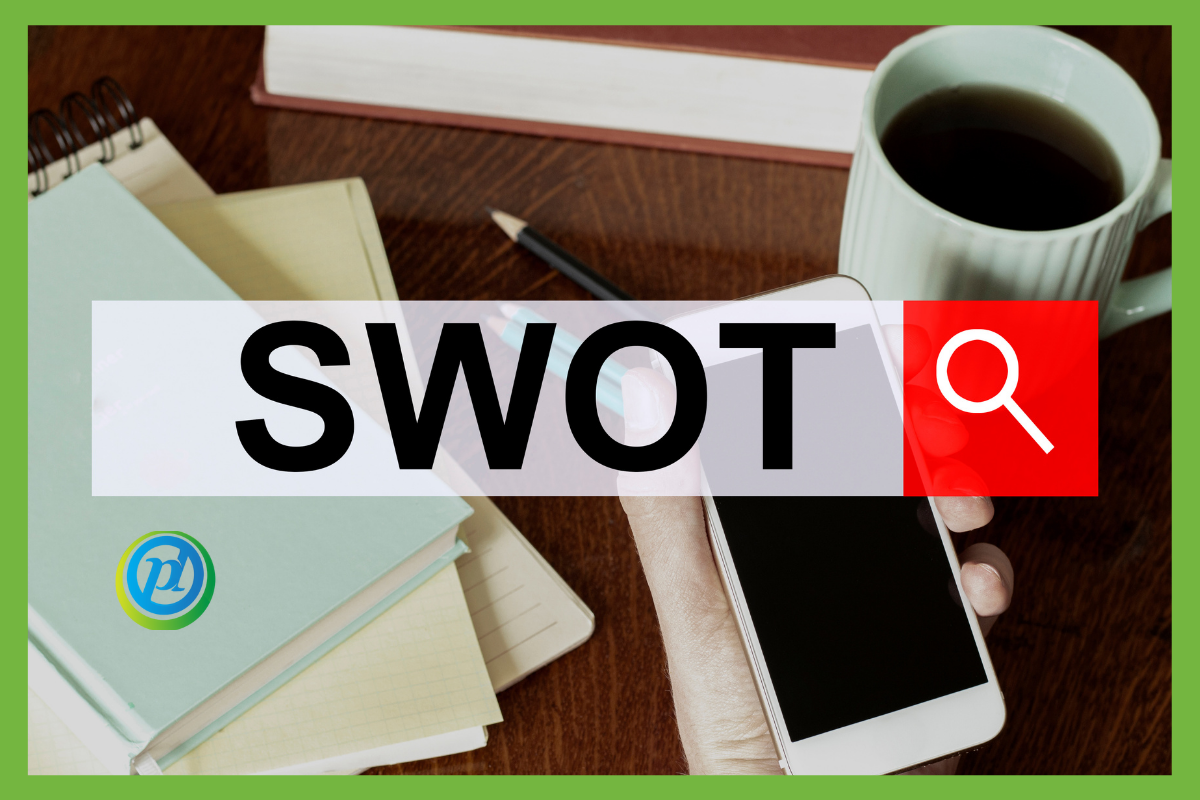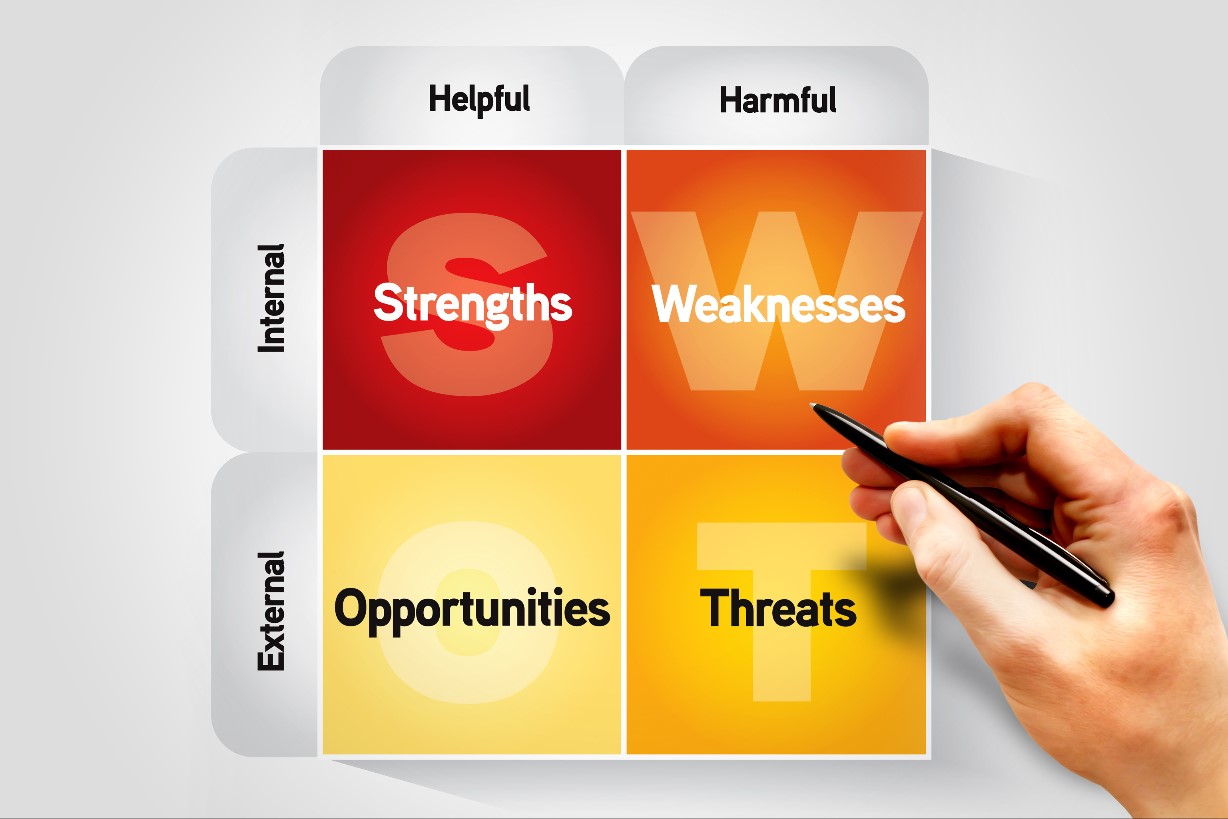SWOT, not to be confused with SWAT (Special Weapons And Tactics) is an acronym that stands for strengths, weaknesses, opportunities, and threats. It is basically a tried-and-true method for evaluating these four parts of a business. The strengths and weaknesses are considered internal factors. These are the operational controls. On the other hand, opportunities and threats are external forces that one cannot control.
Conducting a SWOT analysis is a diligent practice . It enables small business owners to stay in tune with their business. It also keeps you aware of your competition. Ultimately, a SWOT analysis can contribute greatly to your success. In that sense, a SWOT analysis can be a Special Weapon And Tactic one utilizes in order to determine what sets you apart.
A CLOSER LOOK AT SWOT
Conducting a thorough SWOT analysis is not hard, but it does take time and energy. The acronym may seem simple enough, but let’s consider each area up close.
INTERNAL FACTORS
As indicated earlier, internal factors are those that you control and that you can change. The strengths and weaknesses of your business go hand in hand. Some of the areas under your control that you might consider applying SWOT to are: marketing, branding, products or services, finances, and location. These internal factors are not necessarily permanent and can change over time. You decide.
Strengths
Anything that gives you a competitive advantage and benefits your customers is a business strength. Consider those areas or qualities that are causing you success and giving you an advantage over your competitors. For example, what are you doing that attracts customers and gives you an opportunity to acquire more of the market share? Is it that you offer lower prices, higher quality, and/or a larger selection? Identifying these areas will help you leverage them even more.
It is also beneficial to examine the strengths of your competition. Perhaps you can add a twist to what they are doing well and incorporate it into your business.
Weaknesses
Every business has weaknesses. One company cannot possibly be everything to everyone. There are always areas that need improvement. By taking an honest look at these areas, you can determine how to improve or overcome them. For example, you may be a new solopreneur and not have as much experience as your competitor. One solution might be to hire a consultant who can walk you through areas that are weak. The ultimate goal is either to improve and overcome or eliminate that weakness.
EXTERNAL FACTORS
There are numerous external factors that can impact a business. You have no control over these. However, this is not to say that you cannot examine them. By looking at these forces, you might be able to use them to your advantage. Another response may be to adapt your strategies (pivot).
Your competitors are a significant external factor. One should research their competition. By examining their strengths and weaknesses, you are in a better position to compete. Other external forces are things like the pandemic, the war between Russia and Ukraine, and the impact they have on the economy. Sometimes these external influences create opportunities, and sometimes they create threats.
Opportunities
These are influences that can contribute to your company’s success. Usually, they present themselves to you and your competition. The idea is that you want to recognize them and seize them as soon as possible (before your competition does).
For example, during the pandemic, the market changed in such a way that numerous industries were presented with opportunities. There was an increased need for the production of PPE, such as masks, gloves, hand sanitizer, and plastic dividers. Keeping oneself aware of the needs in a market presents opportunities.
Threats
These are external forces that can negatively impact your business, damaging performance and, therefore, success. Like opportunities, they often affect your competition too. Once the threat(s) are identified, they need to be rectified as soon as possible. For example, you may have an unhappy customer who is not satisfied with your product. You need to look for a way to turn that dissatisfied customer into a satisfied one.
A second example was the recent pandemic. Restaurants were one of the industries hardest hit. However, in spite of the threat, many restaurants found ways to survive. They increased their presence online, and found ways to provide first-class delivery service.
Threats come in all shapes and sized. Although they appear at the end in the SWOT analysis, this may be the place to start. The sooner you deal with it, the sooner you can stop it from making irreparable damage.
WHEN TO UTILIZE A SWOT ANALYSIS
There are essentially 3 instances when one should conduct a SWOT analysis. In each instance your business will reap benefits.
Instance 1: Starting Out
Before opening my own business, I participated in a course on Self-Employment. One of the key exercises to complete was a SWOT analysis. In fact, it was/is a critical part of any formal business plan. Banks, lenders and investors will want to see that you have an appreciation and understanding of your businesses strengths, weaknesses, opportunities and possible threats.
By completing this exercise before opening your business you will have a clearer understanding of who you are as a business (vision, mission, brand) what you have to offer and what makes you unique. Furthermore, you will have a clearer idea of what direction your business is going in and who your competition is.
Instance 2: Annually
Any diligent and successful business will conduct an annual SWOT analysis. This helps them stay in tune with their business, the market and the competition. It is a powerful practice. In a few hours of examination, or brainstorming with your team, you can determine what is working well, what needs to be improved upon, negative patterns/practices that need to be eliminated, and new practices that may need to be introduced.
Instance 3: After a Crisis or Uncertain Time
It has been said, “Never let a crisis go to waste.” In recent times the world has faced extreme economic, political and social challenges. The pandemic is an example. Although we hope we are through the worst of it, and hope for the best, we have no guarantee. What worked prior to the pandemic may not work well now. For example the “strengths that allowed you to be successful and move forward in the past may be different from the ones that will make you successful in recovery.”
So the question is how does one move forward? Implementing the SWOT analysis will enable you to plan and get creative for the future. It will ensure that crisis, whatever it may be, will not go to waste where your business is concerned.
HOW TO CONDUCT A SWOT ANALYSIS
If you are to get the most out of conducting a SWOT analysis there are 4 components you need to keep in mind.
1: Be Clear About Your Objective
Swot analysis can be used for numerous areas of your business. You may wish consider sales, marketing, branding or social media. The list can be quite lone. Begin by identifying area that you wish to examine and focus on it. Completing the SWOT for that area is your goal. Remember there is no limit to how many SWOTs you can conduct.
2: Be Honest
It is important to be honest with the whole process. Every detail counts, even those you may not be that excited about or embarrassed about. The only way to grow is to be truthful and candid with each element of SWOT. To do otherwise will not be helpful to you or your business.
3: Be Specific
As much as possible spell out in detail each item you list under each area. Do not leave any grey areas. The more specific you can be, the more productive the process will be. Let’s face it no one knows your business as well as you do.
4: Be Informed
When examining a specific area, be sure that you are relying on credible/reliable information. The market changes rapidly, so use information that is no older than 36 months.
TOOLS TO HELP WITH A SUCCESSFUL ANALYSIS
So you know what a SWOT analysis is, when it can be used, and what components to keep in mind as you complete it. However, it can still be a little intimidating if you have never done one before. The following are two tools that may help.
Tool 1: Use Examples for Inspiration
Be researching and reading a SWOT analysis for a business similar to yours can be of great assistance. Try finding at least 3. Generally speaking they are short, and the more examples you have, the more ideas you may glean for your own analysis.
There are plenty of SWOT examples on the internet. All you have to do is type in SWOT analysis examples in your search and you will be given more than enough information and plenty of images.
Tool 2: Use Brainstorming
Overall, SWOT is a brainstorming activity. There is no one right way to complete it, but the following may prove helpful.
- If you are a solopreneur equip yourself with pen, paper, and/or sticky notes. Find a quiet place and give yourself a couple of hours to complete the exercise. Do not censor your thoughts. No idea is right or wrong, just get it on paper. Work at it until you have exhausted all of your ideas.
- As a solopreneur you can also complete the exercise with some select customers, or invite a consultant to carry out the exercise with you.
- If you are running a small business, set some time aside when you can gather your staff together for the exercise. Equip each of them post-it-notes and have them brainstorm on their own, or in a team. Then, have them place their notes in the appropriate category. Once completed, examine together.
 NOW WHAT?
NOW WHAT?
You have conducted your analysis, and have collected all the information. Now, it is important to take the time to sift through each category. Select what are the most important items. You may have 2-3 items in each category that merit attention.
Next, make a plan. Consider each item. Determine what actions you will take to capitalize on your strengths. Determine how to deal with your weaknesses. Will you look for ways to improve them or eliminate them altogether. Find a way to seize the opportunities so that you can grow in the market. Finally look for ways and take steps to minimize the threat(s).
SWOT analysis is a Special Weapon And Tactic your business can have in its arsenal. While it may take time, energy and practice to complete, it is well worth it. By diligently completing the task you will discover what sets you apart, how to expand and develop, as well as minimize what may be holding you back.
________________________________________________________________________
Pro Ledger Online offers a cloud-based bookkeeping solution for small business professionals. Click here for a 30-day free trial. – www.pro-ledger.com “Bookkeeping Made Simple






